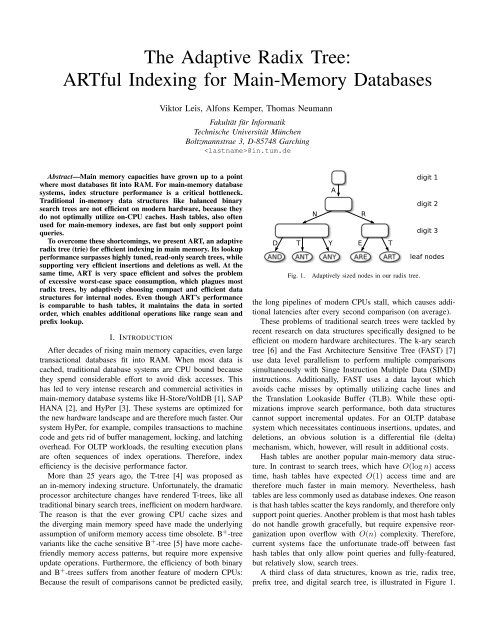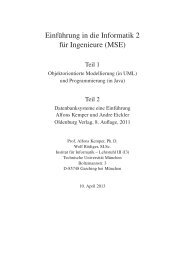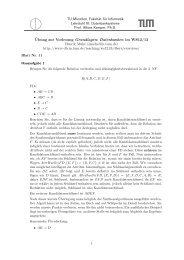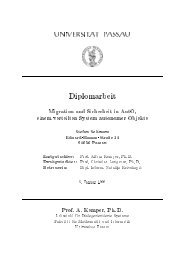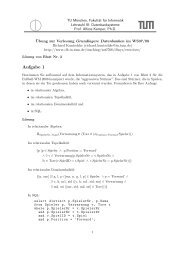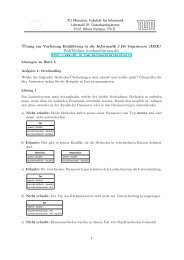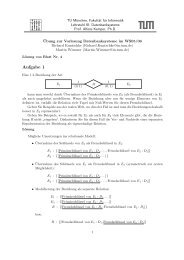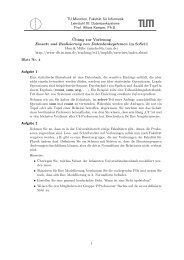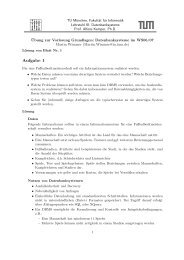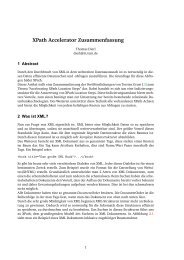The Adaptive Radix Tree: ARTful Indexing for Main-Memory ...
The Adaptive Radix Tree: ARTful Indexing for Main-Memory ...
The Adaptive Radix Tree: ARTful Indexing for Main-Memory ...
You also want an ePaper? Increase the reach of your titles
YUMPU automatically turns print PDFs into web optimized ePapers that Google loves.
<strong>The</strong> <strong>Adaptive</strong> <strong>Radix</strong> <strong>Tree</strong>:<br />
<strong>ARTful</strong> <strong>Indexing</strong> <strong>for</strong> <strong>Main</strong>-<strong>Memory</strong> Databases<br />
Viktor Leis, Alfons Kemper, Thomas Neumann<br />
Fakultät für In<strong>for</strong>matik<br />
Technische Universität München<br />
Boltzmannstrae 3, D-85748 Garching<br />
@in.tum.de<br />
Abstract—<strong>Main</strong> memory capacities have grown up to a point<br />
where most databases fit into RAM. For main-memory database<br />
systems, index structure per<strong>for</strong>mance is a critical bottleneck.<br />
Traditional in-memory data structures like balanced binary<br />
search trees are not efficient on modern hardware, because they<br />
do not optimally utilize on-CPU caches. Hash tables, also often<br />
used <strong>for</strong> main-memory indexes, are fast but only support point<br />
queries.<br />
To overcome these shortcomings, we present ART, an adaptive<br />
radix tree (trie) <strong>for</strong> efficient indexing in main memory. Its lookup<br />
per<strong>for</strong>mance surpasses highly tuned, read-only search trees, while<br />
supporting very efficient insertions and deletions as well. At the<br />
same time, ART is very space efficient and solves the problem<br />
of excessive worst-case space consumption, which plagues most<br />
radix trees, by adaptively choosing compact and efficient data<br />
structures <strong>for</strong> internal nodes. Even though ART’s per<strong>for</strong>mance<br />
is comparable to hash tables, it maintains the data in sorted<br />
order, which enables additional operations like range scan and<br />
prefix lookup.<br />
I. INTRODUCTION<br />
After decades of rising main memory capacities, even large<br />
transactional databases fit into RAM. When most data is<br />
cached, traditional database systems are CPU bound because<br />
they spend considerable ef<strong>for</strong>t to avoid disk accesses. This<br />
has led to very intense research and commercial activities in<br />
main-memory database systems like H-Store/VoltDB [1], SAP<br />
HANA [2], and HyPer [3]. <strong>The</strong>se systems are optimized <strong>for</strong><br />
the new hardware landscape and are there<strong>for</strong>e much faster. Our<br />
system HyPer, <strong>for</strong> example, compiles transactions to machine<br />
code and gets rid of buffer management, locking, and latching<br />
overhead. For OLTP workloads, the resulting execution plans<br />
are often sequences of index operations. <strong>The</strong>re<strong>for</strong>e, index<br />
efficiency is the decisive per<strong>for</strong>mance factor.<br />
More than 25 years ago, the T-tree [4] was proposed as<br />
an in-memory indexing structure. Un<strong>for</strong>tunately, the dramatic<br />
processor architecture changes have rendered T-trees, like all<br />
traditional binary search trees, inefficient on modern hardware.<br />
<strong>The</strong> reason is that the ever growing CPU cache sizes and<br />
the diverging main memory speed have made the underlying<br />
assumption of uni<strong>for</strong>m memory access time obsolete. B + -tree<br />
variants like the cache sensitive B + -tree [5] have more cachefriendly<br />
memory access patterns, but require more expensive<br />
update operations. Furthermore, the efficiency of both binary<br />
and B + -trees suffers from another feature of modern CPUs:<br />
Because the result of comparisons cannot be predicted easily,<br />
D<br />
T<br />
Fig. 1.<br />
N<br />
Y<br />
A<br />
E<br />
R<br />
<strong>Adaptive</strong>ly sized nodes in our radix tree.<br />
T<br />
digit 1<br />
digit 2<br />
digit 3<br />
leaf nodes<br />
the long pipelines of modern CPUs stall, which causes additional<br />
latencies after every second comparison (on average).<br />
<strong>The</strong>se problems of traditional search trees were tackled by<br />
recent research on data structures specifically designed to be<br />
efficient on modern hardware architectures. <strong>The</strong> k-ary search<br />
tree [6] and the Fast Architecture Sensitive <strong>Tree</strong> (FAST) [7]<br />
use data level parallelism to per<strong>for</strong>m multiple comparisons<br />
simultaneously with Singe Instruction Multiple Data (SIMD)<br />
instructions. Additionally, FAST uses a data layout which<br />
avoids cache misses by optimally utilizing cache lines and<br />
the Translation Lookaside Buffer (TLB). While these optimizations<br />
improve search per<strong>for</strong>mance, both data structures<br />
cannot support incremental updates. For an OLTP database<br />
system which necessitates continuous insertions, updates, and<br />
deletions, an obvious solution is a differential file (delta)<br />
mechanism, which, however, will result in additional costs.<br />
Hash tables are another popular main-memory data structure.<br />
In contrast to search trees, which have O(log n) access<br />
time, hash tables have expected O(1) access time and are<br />
there<strong>for</strong>e much faster in main memory. Nevertheless, hash<br />
tables are less commonly used as database indexes. One reason<br />
is that hash tables scatter the keys randomly, and there<strong>for</strong>e only<br />
support point queries. Another problem is that most hash tables<br />
do not handle growth gracefully, but require expensive reorganization<br />
upon overflow with O(n) complexity. <strong>The</strong>re<strong>for</strong>e,<br />
current systems face the un<strong>for</strong>tunate trade-off between fast<br />
hash tables that only allow point queries and fully-featured,<br />
but relatively slow, search trees.<br />
A third class of data structures, known as trie, radix tree,<br />
prefix tree, and digital search tree, is illustrated in Figure 1.
<strong>The</strong>se data structures directly use the digital representation of<br />
keys instead of hashing or comparing keys. <strong>The</strong> underlying<br />
idea is similar to a thumb-index found in many alphabetically<br />
ordered dictionary books: <strong>The</strong> first character of a word can<br />
directly be used to jump to all words starting with that<br />
character. In a computer, this process can be repeated with<br />
the next characters until a match is found. As a consequence<br />
of this process, all operations have O(k) complexity where k is<br />
the length of the key. In the era of extremely large data sets,<br />
when n is growing faster than k, having a time complexity<br />
independent of n is very attractive.<br />
In this work, we present the adaptive radix tree (ART) which<br />
is a fast and space-efficient in-memory indexing structure<br />
specifically tuned <strong>for</strong> modern hardware. While most radix<br />
trees require to trade off tree height versus space efficiency<br />
by setting a globally valid fanout parameter, ART adapts the<br />
representation of every individual node, as exemplified in<br />
Figure 1. By adapting each inner node locally, it optimizes<br />
global space utilization and access efficiency at the same time.<br />
Nodes are represented using a small number of efficient and<br />
compact data structures, chosen dynamically depending on<br />
the number of child nodes. Two additional techniques, path<br />
compression and lazy expansion, allow ART to efficiently<br />
index long keys by collapsing nodes and thereby decreasing<br />
the tree height.<br />
A useful property of radix trees is that the order of the keys<br />
is not random as in hash tables; rather, the keys are ordered<br />
bitwise lexicographically. We show how typical data types can<br />
be reordered efficiently to support all operations that require<br />
the data to be ordered (e.g., range scan, prefix lookup, top-k,<br />
minimum, and maximum).<br />
This work makes the following contributions:<br />
• We develop the adaptive radix tree (ART), a fast and<br />
space-efficient general-purpose indexing structure <strong>for</strong><br />
main-memory database systems.<br />
• We prove that the space consumption per key is bounded<br />
to 52 bytes, even <strong>for</strong> arbitrarily long keys. We show<br />
experimentally, that the space consumption is much lower<br />
in practice, often as low as 8.1 bytes per key.<br />
• We describe how common built-in data types can be<br />
stored in radix trees while retaining their order.<br />
• We experimentally evaluate ART and other state of the<br />
art main-memory index structures, including the most<br />
efficient search tree proposals.<br />
• By integrating ART into the main-memory database<br />
system HyPer and running the TPC-C benchmark, we<br />
prove its superior end-to-end per<strong>for</strong>mance in a “real-life”<br />
transaction processing application.<br />
<strong>The</strong> rest of this paper is organized as follows. <strong>The</strong> next section<br />
discusses related work. Section III presents the adaptive<br />
radix tree and analyzes its space consumption. In Section IV<br />
we introduce the concept of binary-comparable keys and show<br />
how common built-in types can be trans<strong>for</strong>med. Section V<br />
describes experimental results including a number of micro<br />
benchmarks and the TPC-C benchmark. Finally, Section VI<br />
concludes and discusses future work.<br />
II. RELATED WORK<br />
In disk-based database systems, the B + -tree [8] is ubiquitous<br />
[9]. It retrieves large blocks from disk to reduce the<br />
number of accesses. Red-black trees [10], [11] and T-trees<br />
[4] were proposed <strong>for</strong> main-memory database systems. Rao<br />
and Ross [5] showed that T-trees, like all binary search trees,<br />
suffer from poor cache behavior and are there<strong>for</strong>e often slower<br />
than B + -trees on modern hardware. As an alternative, they<br />
proposed a cache conscious B + -tree variant, the CSB + -tree<br />
[12]. Further cache optimizations <strong>for</strong> B + -trees were surveyed<br />
by Graefe and Larson [13].<br />
Modern CPUs allow to per<strong>for</strong>m multiple comparisons with<br />
a single SIMD instruction. Schlegel et al. [6] proposed k-<br />
ary search which reduces the number of comparisons from<br />
log 2 n to log K n where K is the number of keys that fit<br />
into one SIMD vector. In comparison with binary trees, this<br />
technique also reduces the number of cache misses, because<br />
K comparisons are per<strong>for</strong>med <strong>for</strong> each cache line loaded<br />
from main memory. Kim et al. extended this research by<br />
proposing FAST, a methodology <strong>for</strong> laying out binary search<br />
trees in an architecture sensitive way [7]. SIMD, cache line,<br />
and page blocking are used to optimally use the available<br />
cache and memory bandwidth. Additionally, they proposed to<br />
interleave the stages of multiple queries in order to increase<br />
the throughput of their search algorithm. FAST trees and<br />
the k-ary search trees are pointer-free data structures which<br />
store all keys in a single array and use offset calculations<br />
to traverse the tree. While this representation is efficient and<br />
saves space, it also implies that no online updates are possible.<br />
Kim et al. also presented a GPU implementation of FAST and<br />
compared its per<strong>for</strong>mance to modern CPUs. <strong>The</strong>ir results show<br />
that, due to the higher memory bandwidth, GPUs can achieve<br />
higher throughput than CPUs. Nevertheless, the use of GPUs<br />
as dedicated indexing hardware is not yet practical because<br />
memory capacities of GPUs are limited, communications cost<br />
with main memory is high, and hundreds of parallel queries<br />
are needed to achieve high throughput. We, there<strong>for</strong>e focus on<br />
index structures <strong>for</strong> CPUs.<br />
<strong>The</strong> use of tries <strong>for</strong> indexing character strings has been<br />
studied extensively. <strong>The</strong> two earliest variants use lists [14]<br />
and arrays [15] as internal node representations. Morrison<br />
introduced path compression in order to store long strings<br />
efficiently [16]. Knuth [17] analyzes these early trie variants.<br />
<strong>The</strong> burst trie is a more recent proposal which uses trie nodes<br />
<strong>for</strong> the upper levels of the tree, but switches to a linked list<br />
once a subtree has only few elements. <strong>The</strong> HAT-trie [18]<br />
improves per<strong>for</strong>mance by replacing the linked list with a<br />
hash table. While most research focused on indexing character<br />
strings, our goal is to index other data types as well. <strong>The</strong>re<strong>for</strong>e,<br />
we prefer the term radix tree over trie because it underscores<br />
the similarity to the radix sort algorithm and emphasizes that<br />
arbitrary data can be indexed instead of only character strings.<br />
<strong>The</strong> Generalized Prefix <strong>Tree</strong> was proposed by Boehm et<br />
al. [19] as a general-purpose indexing structure. It is a radix<br />
tree with a fanout of 16 and was a finalist in the SIGMOD
Programming Contest 2009. <strong>The</strong> KISS-<strong>Tree</strong> [20] is a more<br />
efficient radix tree proposal with only three levels, but can<br />
only store 32 bit keys. It uses an open addressing scheme <strong>for</strong><br />
the first 16 bits of the key and relies on the virtual memory<br />
system to save space. <strong>The</strong> second level, responsible <strong>for</strong> the<br />
next 10 bits, uses an array representation and the final level<br />
compresses 6 bits using a bit vector. <strong>The</strong> idea of dynamically<br />
changing the internal node representation is used by the Judy<br />
array data structure which was developed at Hewlett-Packard<br />
research labs [21], [22].<br />
Graefe discusses binary-comparable (“normalized”) keys,<br />
e.g. [23], as a way of simplifying and speeding up key<br />
comparisons. We use this concept to obtain meaningful order<br />
<strong>for</strong> the keys stored in radix trees.<br />
III. ADAPTIVE RADIX TREE<br />
This section presents the adaptive radix tree (ART). We start<br />
with some general observations on the advantages of radix<br />
trees over comparison-based trees. Next, we motivate the use<br />
of adaptive nodes by showing that the space consumption<br />
of conventional radix trees can be excessive. We continue<br />
with describing ART and algorithms <strong>for</strong> search and insertion.<br />
Finally, we analyze the space consumption.<br />
A. Preliminaries<br />
<strong>Radix</strong> trees have a number of interesting properties that<br />
distinguish them from comparison-based search trees:<br />
• <strong>The</strong> height (and complexity) of radix trees depends on<br />
the length of the keys but in general not on the number<br />
of elements in the tree.<br />
• <strong>Radix</strong> trees require no rebalancing operations and all<br />
insertion orders result in the same tree.<br />
• <strong>The</strong> keys are stored in lexicographic order.<br />
• <strong>The</strong> path to a leaf node represents the key of that<br />
leaf. <strong>The</strong>re<strong>for</strong>e, keys are stored implicitly and can be<br />
reconstructed from paths.<br />
<strong>Radix</strong> trees consist of two types of nodes: Inner nodes,<br />
which map partial keys to other nodes, and leaf nodes, which<br />
store the values corresponding to the keys. <strong>The</strong> most efficient<br />
representation of an inner node is as an array of 2 s pointers.<br />
During tree traversal, an s bit chunk of the key is used as the<br />
index into that array and thereby determines the next child<br />
node without any additional comparisons. <strong>The</strong> parameter s,<br />
which we call span, is critical <strong>for</strong> the per<strong>for</strong>mance of radix<br />
trees, because it determines the height of the tree <strong>for</strong> a given<br />
key length: A radix tree storing k bit keys has ⌈k/s⌉ levels of<br />
inner nodes. With 32 bit keys, <strong>for</strong> example, a radix tree using<br />
s = 1 has 32 levels, while a span of 8 results in only 4 levels.<br />
Because comparison-based search trees are the prevalent<br />
indexing structures in database systems, it is illustrative to<br />
compare the height of radix trees with the number of comparisons<br />
in perfectly balanced search trees. While each comparison<br />
rules out half of all values in the best case, a radix tree<br />
node can rule out more values if s > 1. <strong>The</strong>re<strong>for</strong>e, radix trees<br />
have smaller height than binary search trees <strong>for</strong> n > 2 k/s . This<br />
relationship is illustrated in Figure 2 and assumes that keys<br />
Fig. 2.<br />
tree height<br />
k<br />
k 4<br />
k 8<br />
perfect BST<br />
radix tree (s=4)<br />
radix tree (s=8)<br />
0 (k 4)<br />
2 (k 8) 2 2 k<br />
tree size in # keys (log scale)<br />
<strong>Tree</strong> height of perfectly balanced binary search trees and radix trees.<br />
can be compared in O(1) time. For large keys, comparisons<br />
actually take O(k) time and there<strong>for</strong>e the complexity of search<br />
trees is O(k log n), as opposed to the radix tree complexity of<br />
O(k). <strong>The</strong>se observations suggest that radix trees, in particular<br />
with a large span, can be more efficient than traditional search<br />
trees.<br />
B. <strong>Adaptive</strong> Nodes<br />
As we have seen, from a (pure lookup) per<strong>for</strong>mance standpoint,<br />
it is desirable to have a large span. When arrays of<br />
pointers are used to represent inner nodes, the disadvantage<br />
of a large span is also clear: Space usage can be excessive<br />
when most child pointers are null. This tradeoff is illustrated<br />
in Figure 3 which shows the height and space consumption<br />
<strong>for</strong> different values of the span parameter when storing 1M<br />
uni<strong>for</strong>mly distributed 32 bit integers. As the span increases,<br />
the tree height decreases linearly, while the space consumption<br />
increases exponentially. <strong>The</strong>re<strong>for</strong>e, in practice, only some<br />
values of s offer a reasonable tradeoff between time and space.<br />
For example, the Generalized Prefix <strong>Tree</strong> (GPT) uses a span of<br />
4 bits [19], and the radix tree used in the Linux kernel (LRT)<br />
uses 6 bits [24]. Figure 3 further shows that our adaptive radix<br />
tree (ART), at the same time, uses less space and has smaller<br />
height than radix trees that only use homogeneous array nodes.<br />
<strong>The</strong> key idea that achieves both space and time efficiency is<br />
to adaptively use different node sizes with the same, relatively<br />
large span, but with different fanout. Figure 4 illustrates this<br />
tree height<br />
32<br />
24<br />
16<br />
8<br />
1<br />
s=1<br />
s=2<br />
s=3<br />
GPT (s=4)<br />
LRT (s=6)<br />
s=8<br />
ART<br />
s=12s=14 s=16<br />
s=32<br />
32MB 128MB 512MB 2GB 8GB 32GB<br />
space consumption (log scale)<br />
Fig. 3. <strong>Tree</strong> height and space consumption <strong>for</strong> different values of the span<br />
parameter s when storing 1M uni<strong>for</strong>mly distributed 32 bit integers. Pointers<br />
are 8 byte long and nodes are expanded lazily.
Fig. 4.<br />
Illustration of a radix tree using array nodes (left) and our adaptive radix tree ART (right).<br />
idea and shows that adaptive nodes do not affect the structure<br />
(i.e., height) of the tree, only the sizes of the nodes. By<br />
reducing space consumption, adaptive nodes allow to use a<br />
larger span and there<strong>for</strong>e increase per<strong>for</strong>mance too.<br />
In order to efficiently support incremental updates, it is<br />
too expensive to resize nodes after each update. <strong>The</strong>re<strong>for</strong>e,<br />
we use a small number of node types, each with a different<br />
fanout. Depending on the number of non-null children, the<br />
appropriate node type is used. When the capacity of a node<br />
is exhausted due to insertion, it is replaced by a larger node<br />
type. Correspondingly, when a node becomes underfull due to<br />
key removal, it is replaced by a smaller node type.<br />
C. Structure of Inner Nodes<br />
Conceptually, inner nodes map partial keys to child pointers.<br />
Internally, we use four data structures with different capacities.<br />
Given the next key byte, each data structure allows to efficiently<br />
find, add, and remove a child node. Additionally, the<br />
child pointers can be scanned in sorted order, which allows to<br />
implement range scans. We use a span of 8 bits, corresponding<br />
to partial keys of 1 byte and resulting a relatively large<br />
fanout. This choice also has the advantage of simplifying the<br />
implementation, because bytes are directly addressable which<br />
avoids bit shifting and masking operations.<br />
<strong>The</strong> four node types are illustrated in Figure 5 and are<br />
named according to their maximum capacity. Instead of using<br />
a list of key/value pairs, we split the list into one key part<br />
and one pointer part. This allows to keep the representation<br />
compact while permitting efficient search:<br />
Node4: <strong>The</strong> smallest node type can store up to 4 child<br />
pointers and uses an array of length 4 <strong>for</strong> keys and another<br />
array of the same length <strong>for</strong> pointers. <strong>The</strong> keys and pointers<br />
are stored at corresponding positions and the keys are sorted.<br />
Node16: This node type is used <strong>for</strong> storing between 5 and<br />
16 child pointers. Like the Node4, the keys and pointers<br />
are stored in separate arrays at corresponding positions, but<br />
both arrays have space <strong>for</strong> 16 entries. A key can be found<br />
efficiently with binary search or, on modern hardware, with<br />
parallel comparisons using SIMD instructions.<br />
Node48: As the number of entries in a node increases,<br />
searching the key array becomes expensive. <strong>The</strong>re<strong>for</strong>e, nodes<br />
with more than 16 pointers do not store the keys explicitly.<br />
Instead, a 256-element array is used, which can be indexed<br />
with key bytes directly. If a node has between 17 and 48 child<br />
pointers, this array stores indexes into a second array which<br />
contains up to 48 pointers. This indirection saves space in<br />
Node4<br />
Node16<br />
Node48<br />
Node256<br />
key<br />
0 2 3<br />
key<br />
child pointer<br />
child pointer<br />
0 1 2 15 0 1 2 15<br />
0 2 3 … 255<br />
…<br />
0 1 2<br />
child index<br />
0 1 2<br />
a<br />
0 1 2 3 0 1 2 3<br />
3 255<br />
…<br />
b<br />
255<br />
b<br />
child pointer<br />
c<br />
child pointer<br />
3 4 5 6 255<br />
…<br />
c<br />
a<br />
a<br />
0<br />
b<br />
Fig. 5. Data structures <strong>for</strong> inner nodes. In each case the partial keys 0, 2,<br />
3, and 255 are mapped to the subtrees a, b, c, and d, respectively.<br />
comparison to 256 pointers of 8 bytes, because the indexes<br />
only require 6 bits (we use 1 byte <strong>for</strong> simplicity).<br />
Node256: <strong>The</strong> largest node type is simply an array of 256<br />
pointers and is used <strong>for</strong> storing between 49 and 256 entries.<br />
With this representation, the next node can be found very<br />
efficiently using a single lookup of the key byte in that array.<br />
No additional indirection is necessary. If most entries are not<br />
null, this representation is also very space efficient because<br />
only pointers need to be stored.<br />
Additionally, at the front of each inner node, a header of<br />
constant size (e.g., 16 bytes) stores the node type, the number<br />
of children, and the compressed path (cf. Section III-E).<br />
D. Structure of Leaf Nodes<br />
Besides storing paths using the inner nodes as discussed<br />
in the previous section, radix trees must also store the values<br />
associated with the keys. We assume that only unique keys<br />
are stored, because non-unique indexes can be implemented<br />
by appending the tuple identifier to each key as a tie-breaker.<br />
<strong>The</strong> values can be stored in different ways:<br />
b<br />
1<br />
a<br />
c<br />
2<br />
c<br />
d<br />
…<br />
d<br />
47<br />
d<br />
d
path compression<br />
merge one-way node<br />
into child node<br />
R<br />
A<br />
B<br />
Z<br />
F<br />
O<br />
O<br />
lazy<br />
expansion<br />
remove path<br />
to single leaf<br />
search (node, key, depth)<br />
1 if node==NULL<br />
2 return NULL<br />
3 if isLeaf(node)<br />
4 if leafMatches(node, key, depth)<br />
5 return node<br />
6 return NULL<br />
7 if checkPrefix(node,key,depth)!=node.prefixLen<br />
8 return NULL<br />
9 depth=depth+node.prefixLen<br />
10 next=findChild(node, key[depth])<br />
11 return search(next, key, depth+1)<br />
Fig. 6.<br />
Illustration of lazy expansion and path compression.<br />
Fig. 7.<br />
Search algorithm.<br />
• Single-value leaves: <strong>The</strong> values are stored using an additional<br />
leaf node type which stores one value.<br />
• Multi-value leaves: <strong>The</strong> values are stored in one of four<br />
different leaf node types, which mirror the structure of<br />
inner nodes, but contain values instead of pointers.<br />
• Combined pointer/value slots: If values fit into pointers,<br />
no separate node types are necessary. Instead, each<br />
pointer storage location in an inner node can either<br />
store a pointer or a value. Values and pointers can be<br />
distinguished using one additional bit per pointer or with<br />
pointer tagging.<br />
Using single-value leaves is the most general method,<br />
because it allows keys and values of varying length within one<br />
tree. However, because of the increased tree height, it causes<br />
one additional pointer traversal per lookup. Multi-value leaves<br />
avoid this overhead, but require all keys in a tree to have the<br />
same length. Combined pointer/value slots are efficient and<br />
allow to store keys of varying length. <strong>The</strong>re<strong>for</strong>e, this method<br />
should be used if applicable. It is particularly attractive <strong>for</strong><br />
secondary database indexes which store tuple identifiers with<br />
the same size as pointers.<br />
E. Collapsing Inner Nodes<br />
<strong>Radix</strong> trees have the useful property that each inner node<br />
represents a key prefix. <strong>The</strong>re<strong>for</strong>e, the keys are implicitly<br />
stored in the tree structure, and can be reconstructed from<br />
the paths to the leaf nodes. This saves space, because the<br />
keys do not have to be stored explicitly. Nevertheless, even<br />
with this implicit prefix compression of keys and the use<br />
of adaptive nodes, there are cases, in particular with long<br />
keys, where the space consumption per key is large. We<br />
there<strong>for</strong>e use two additional, well-known techniques that allow<br />
to decrease the height by reducing the number of nodes.<br />
<strong>The</strong>se techniques are very effective <strong>for</strong> long keys, increasing<br />
per<strong>for</strong>mance significantly <strong>for</strong> such indexes. Equally important<br />
is that they reduce space consumption, and ensure a small<br />
worst-case space bound.<br />
With the first technique, lazy expansion, inner nodes are<br />
only created if they are required to distinguish at least two<br />
leaf nodes. Figure 6 shows an example where lazy expansion<br />
saves two inner nodes by truncating the path to the leaf “FOO”.<br />
This path is expanded if another leaf with the prefix “F” is<br />
inserted. Note that because paths to leaves may be truncated,<br />
this optimization requires that the key is stored at the leaf or<br />
can be retrieved from the database.<br />
Path compression, the second technique, removes all inner<br />
nodes that have only a single child. In Figure 6, the inner node<br />
storing the partial key “A” was removed. Of course, this partial<br />
key cannot simply be ignored. <strong>The</strong>re are two approaches to<br />
deal with it:<br />
• Pessimistic: At each inner node, a variable length (possibly<br />
empty) partial key vector is stored. It contains the<br />
keys of all preceding one-way nodes which have been<br />
removed. During lookup this vector is compared to the<br />
search key be<strong>for</strong>e proceeding to the next child.<br />
• Optimistic: Only the count of preceding one-way nodes<br />
(equal to the length of the vector in the pessimistic<br />
approach) is stored. Lookups just skip this number of<br />
bytes without comparing them. Instead, when a lookup<br />
arrives at a leaf its key must be compared to the search<br />
key to ensure that no “wrong turn” was taken.<br />
Both approaches ensure that each inner node has at least<br />
two children. <strong>The</strong> optimistic approach is particularly beneficial<br />
<strong>for</strong> long strings but requires one additional check, while<br />
the pessimistic method uses more space, and has variable<br />
sized nodes leading to increased memory fragmentation. We<br />
there<strong>for</strong>e use a hybrid approach by storing a vector at each<br />
node like in the pessimistic approach, but with a constant<br />
size (8 bytes) <strong>for</strong> all nodes. Only when this size is exceeded,<br />
the lookup algorithm dynamically switches to the optimistic<br />
strategy. Without wasting too much space or fragmenting<br />
memory, this avoids the additional check in cases that we<br />
investigated.<br />
F. Algorithms<br />
We now present the algorithms <strong>for</strong> search and updates:<br />
Search: Pseudo code <strong>for</strong> search is shown in Figure 7. <strong>The</strong><br />
tree is traversed by using successive bytes of the key array<br />
until a leaf node or a null pointer is encountered. Line 4<br />
handles lazy expansion by checking that the encountered leaf<br />
fully matches the key. Pessimistic path compression is handled<br />
in lines 7 and 8 by aborting the search if the compressed<br />
path does not match the key. <strong>The</strong> next child node is found<br />
by the findChild function, which is shown in Figure 8.<br />
Depending on the node type the appropriate search algorithm<br />
is executed: Because a Node4 has only 2-4 entries, we use
findChild (node, byte)<br />
1 if node.type==Node4 // simple loop<br />
2 <strong>for</strong> (i=0; i
TABLE I<br />
SUMMARY OF THE NODE TYPES (16 BYTE HEADER, 64 BIT POINTERS).<br />
Type Children Space (bytes)<br />
Node4 2-4 16 + 4 + 4 · 8 = 52<br />
Node16 5-16 16 + 16 + 16 · 8 = 160<br />
Node48 17-48 16 + 256 + 48 · 8 = 656<br />
Node256 49-256 16 + 256 · 8 = 2064<br />
TABLE II<br />
WORST-CASE SPACE CONSUMPTION PER KEY (IN BYTES) FOR DIFFERENT<br />
RADIX TREE VARIANTS WITH 64 BIT POINTERS.<br />
k = 32 k → ∞<br />
ART 43 52<br />
GPT 256 ∞<br />
LRT 2048 ∞<br />
KISS >4096 NA.<br />
header storing the node type, the number of non null children,<br />
and the compressed path. We only consider inner nodes and<br />
ignore leaf nodes because leaves incur no space overhead if<br />
combined pointer/value slots with tagged pointers are used.<br />
Using these assumptions, the resulting space consumption <strong>for</strong><br />
each inner node type is shown in Table I.<br />
Think of each leaf as providing x bytes and inner nodes as<br />
consuming space provided by their children. If each node of<br />
a tree has a positive budget, then that tree uses less than x<br />
bytes per key. <strong>The</strong> budget of an inner node is the sum of all<br />
budgets of its children minus the space consumption of that<br />
node. Formally, the budget b(n) of a node n with the child<br />
nodes c(n) and the space consumption s(n) is defined as<br />
{<br />
x, isLeaf(n)<br />
b(n) = ( ∑ )<br />
i∈c(n) b(i) − s(n), else.<br />
Using induction on the node type, we now show that<br />
b(n) ≥ 52 <strong>for</strong> every ART node n if x = 52: For leaves, the<br />
statement holds trivially by definition of the budget function.<br />
To show that the statement holds <strong>for</strong> inner nodes, we compute<br />
a lower bound <strong>for</strong> ∑ i∈c(n)<br />
b(i) using the induction hypothesis<br />
and the minimum number of children <strong>for</strong> each node type. After<br />
subtracting the corresponding space consumption, we obtain<br />
a lower bound on the budget of each node type. In all four<br />
cases it is greater than or equal to 52, which concludes the<br />
induction. To summarize, we have shown that <strong>for</strong> x = 52 it<br />
is not possible to construct an adaptive radix tree node that<br />
has a negative budget. As a consequence, the worst-case space<br />
consumption is 52 bytes <strong>for</strong> any adaptive radix tree, even <strong>for</strong><br />
arbitrarily long keys. It can also be shown analogously that<br />
with six node types 1 , the worst-case space consumption can be<br />
reduced to 34 bytes per key. As we will show in Section V-D,<br />
in practice, the space consumption is much smaller than the<br />
worst case, even <strong>for</strong> relatively long keys. <strong>The</strong> best case of 8.1<br />
bytes, however, does occur quite frequently because surrogate<br />
integer keys are often dense.<br />
1 <strong>The</strong> Node4 type is replaced by the new node types Node2 and Node5<br />
and the Node48 type is replaced by the new Node32 and Node64 types.<br />
Let us close with a comparison to other radix trees which is<br />
summarized in Table II. Because the Generalized Prefix <strong>Tree</strong><br />
and the Linux kernel radix tree do not use path compression,<br />
the number of inner nodes is proportional to the length of the<br />
keys. <strong>The</strong>re<strong>for</strong>e, the worst-case space consumption per key<br />
is not bounded. Furthermore, even <strong>for</strong> short keys, both data<br />
structures have a much higher worst-case space consumption<br />
than ART because they do not use adaptive nodes. <strong>The</strong> worstcase<br />
space consumption of the KISS-<strong>Tree</strong> is over 4KB per<br />
key, and occurs, <strong>for</strong> example, with the unsigned integer keys<br />
{i · 2 16 | i ∈ {0, 1, . . . , 2 16 − 1}}.<br />
IV. CONSTRUCTING BINARY-COMPARABLE KEYS<br />
An important aspect in choosing an indexing structure is<br />
whether or not the data is stored in sorted order. <strong>The</strong> sorted<br />
order traversal of an index structure facilitates the implementation<br />
of efficient ordered range scans and lookups <strong>for</strong> minimum,<br />
maximum, top-N, etc. By default, only comparison-based<br />
trees store the data in sorted order, which resulted in their<br />
prevalence as indexing structures <strong>for</strong> database systems. While<br />
the use of order-preserving hashing has been proposed to allow<br />
hash table elements to be sorted, it is not common in realworld<br />
systems. <strong>The</strong> reason is that <strong>for</strong> values from unknown<br />
distributions, it is very hard to come up with functions that<br />
spread the input values uni<strong>for</strong>mly over the hash table while<br />
preserving the input order.<br />
Keys stored in radix trees are ordered bitwise lexicographically.<br />
For some data types, e.g., ASCII encoded character<br />
strings, this yields the expected order. For most data types<br />
this is not the case. For example, negative two-complement<br />
signed integers are lexicographically greater than positive<br />
integers. However, it is possible to obtain the desired order<br />
by trans<strong>for</strong>ming the keys. We call the values resulting from<br />
such a trans<strong>for</strong>mation binary-comparable keys. If only binarycomparable<br />
keys are used as keys of a radix tree, the data<br />
is stored in sorted order and all operations that rely on this<br />
order can be supported. Note that no modifications to the<br />
algorithms presented in the previous section are necessary.<br />
Each key must simply be trans<strong>for</strong>med to a binary-comparable<br />
key be<strong>for</strong>e storing it or looking it up.<br />
Binary-comparable keys have other use cases. Just as this<br />
concept allows to replace comparison-based trees with radix<br />
trees, it allows to replace comparison-based sorting algorithms<br />
like quicksort or mergesort with the radix sort algorithm which<br />
can be asymptotically superior.<br />
A. Definition<br />
A trans<strong>for</strong>mation function t : D → {0, 1, . . . , 255} k<br />
trans<strong>for</strong>ms values of a domain D to binary-comparable keys of<br />
length k if it satisfies the following equivalences (x, y ∈ D):<br />
• x < y ⇔ memcmp k (t(x), t(y)) < 0<br />
• x > y ⇔ memcmp k (t(x), t(y)) > 0<br />
• x = y ⇔ memcmp k (t(x), t(y)) = 0<br />
<strong>The</strong> operators ,= denote the usual relational operators<br />
on the input type while memcmp k compares the two input<br />
vectors component wise. It returns 0 if all compared values
are equal, a negative value if the first non-equal value of the<br />
first vector is less than the corresponding byte of the second<br />
vector, and otherwise a positive value.<br />
For finite domains, it is always possible to trans<strong>for</strong>m the values<br />
of any strictly totally ordered domain to binary-comparable<br />
keys: Each value of a domain size n is mapped to a string of<br />
⌈log 2 n⌉ bits storing the zero-extended rank minus one.<br />
B. Trans<strong>for</strong>mations<br />
We now discuss how common data types can be trans<strong>for</strong>med<br />
to binary-comparable keys.<br />
a) Unsigned Integers: <strong>The</strong> binary representation of unsigned<br />
integers already has the desired order. However, the<br />
endianness of the machine must be taken into account when<br />
storing the value into main memory. On little endian machines,<br />
the byte order must be swapped to ensure that the result is<br />
ordered from most to least significant byte.<br />
b) Signed Integers: Signed two-complement integers<br />
must be reordered because negative integers are ordered descending<br />
and are greater than the positive values. An b bit<br />
integer x is trans<strong>for</strong>med very efficiently by flipping the sign<br />
bit (using x XOR 2 b−1 ). <strong>The</strong> resulting value is then stored like<br />
an unsigned value.<br />
c) IEEE 754 Floating Point Numbers: For floating point<br />
values, the trans<strong>for</strong>mation is more involved, although conceptually<br />
not difficult. Each value is first classified as positive<br />
or negative, and as normalized number, denormalized number,<br />
NaN, ∞, or 0. Because these 10 classes do not overlap, a new<br />
rank can easily be computed and then stored like an unsigned<br />
value. One key trans<strong>for</strong>mation requires 3 if statements, 1<br />
integer multiplication, and 2 additions.<br />
d) Character Strings: <strong>The</strong> Unicode Collation Algorithm<br />
(UCA) defines complex rules <strong>for</strong> comparing Unicode strings.<br />
<strong>The</strong>re are open source libraries which implement this algorithm<br />
and which offer functions to trans<strong>for</strong>m Unicode strings<br />
to binary-comparable keys 2 . In general, it is important that<br />
each string is terminated with a value which does not appear<br />
anywhere else in any string (e.g., the 0 byte). <strong>The</strong> reason is<br />
that keys must not be prefixes of other keys.<br />
e) Null: To make a null value binary comparable, it must<br />
be assigned a value with some particular rank. For most data<br />
types, all possible values are already used. A simple solution<br />
is to increase the key length of all values by one to obtain<br />
space <strong>for</strong> the null value, e.g., 4 byte integers become 5 bytes<br />
long. A more efficient way to accommodate the null value is<br />
to increase the length only <strong>for</strong> some values of the domain. For<br />
example, assuming null should be less than all other 4 byte<br />
integers, null can be mapped to the byte sequence 0,0,0,0,0,<br />
the previously smallest value 0 is mapped to 0,0,0,0,1, and all<br />
other values retain their 4 byte representation.<br />
f) Compound Keys: Keys consisting of multiple attributes<br />
are easily handled by trans<strong>for</strong>ming each attribute separately<br />
and concatenating the results.<br />
2 <strong>The</strong> C/C++ library “International Components <strong>for</strong> Unicode”<br />
(http://site.icu-project.org/), <strong>for</strong> example, provides the ucol_getSortKey<br />
function <strong>for</strong> this purpose.<br />
V. EVALUATION<br />
In this section, we experimentally evaluate ART and compare<br />
its per<strong>for</strong>mance to alternative in-memory data structures,<br />
including comparison-based trees, hashing, and radix trees.<br />
<strong>The</strong> evaluation has two parts: First, we per<strong>for</strong>m a number of<br />
micro benchmarks, implemented as standalone programs, with<br />
all evaluated data structures. In the second part, we integrate<br />
some of the data structures into the main-memory database<br />
system HyPer. This allows us to execute a more realistic<br />
workload, the standard OLTP benchmark TPC-C.<br />
We used a high-end desktop system with an Intel Core i7<br />
3930K CPU which has 6 cores, 12 threads, 3.2 GHz clock<br />
rate, and 3.8 GHz turbo frequency. <strong>The</strong> system has 12 MB<br />
shared, last-level cache and 32 GB quad-channel DDR3-1600<br />
RAM. We used Linux 3.2 in 64 bit mode as operating system<br />
and GCC 4.6 as compiler.<br />
As contestants, we used<br />
• a B + -tree optimized <strong>for</strong> main memory (Cache-Sensitive<br />
B + -tree [CSB]),<br />
• two read-only search structures optimized <strong>for</strong> modern<br />
x86 CPUs (k-ary search tree [kary], Fast Architecture<br />
Sensitive <strong>Tree</strong> [FAST]),<br />
• a radix tree (Generalized Prefix <strong>Tree</strong> [GPT]), and<br />
• two textbook data structures (red-black tree [RB], chained<br />
hash table [HT] using MurmurHash64A <strong>for</strong> 64-bit plat<strong>for</strong>ms<br />
[25]).<br />
For a fair comparison, we used source code provided by the<br />
authors if it was available. This was the case <strong>for</strong> the CSB + -<br />
<strong>Tree</strong> [26], k-ary search [27], and the Generalized Prefix <strong>Tree</strong><br />
[28]. We used our own implementation <strong>for</strong> the remaining data<br />
structures.<br />
We were able to validate that our implementation of FAST,<br />
which we made available online [29], matches the originally<br />
published numbers. To calibrate <strong>for</strong> the different hardware,<br />
we used the results <strong>for</strong> k-ary search which were published<br />
in the same paper. Our implementation of FAST uses 2 MB<br />
memory pages, and aligns all cache line blocks to 64 byte<br />
boundaries, as suggested by Yamamuro et al. [30]. However,<br />
because FAST and k-ary search return the rank of the key<br />
instead of the tuple identifier, the following results include<br />
one additional lookup in a separate array of tuple identifiers in<br />
order to evaluate a meaningful lookup in the database context.<br />
We had to use 32 bit integers as keys <strong>for</strong> the micro benchmarks<br />
because some of the implementations only support 32<br />
bit integer keys. For such very short keys, path compression<br />
usually increases space consumption instead of reducing it.<br />
<strong>The</strong>re<strong>for</strong>e, we removed this feature <strong>for</strong> the micro benchmarks.<br />
Path compression is enabled in the more realistic second part<br />
of the evaluation. In contrast to comparison-based trees and<br />
hash tables, the per<strong>for</strong>mance of radix trees varies with the<br />
distribution of the keys. We there<strong>for</strong>e show results <strong>for</strong> dense<br />
keys ranging from 1 to n (n denotes the size of the tree in #<br />
keys) and sparse keys where each bit is equally likely 0 or 1.<br />
We randomly permuted the dense keys.
65K<br />
20<br />
16M<br />
10.0<br />
256M<br />
M lookups/second<br />
90<br />
60<br />
30<br />
dense<br />
sparse<br />
M lookups/second<br />
15<br />
10<br />
5<br />
dense<br />
sparse<br />
M lookups/second<br />
7.5<br />
5.0<br />
2.5<br />
dense<br />
sparse<br />
0<br />
0<br />
0.0<br />
ART GPT RB CSB kary FAST HT<br />
ART GPT RB CSB kary FAST HT<br />
ART RB kary FAST HT<br />
(GPT and CSB crashed)<br />
Fig. 10. Single-threaded lookup throughput in an index with 65K, 16M, and 256M keys.<br />
A. Search Per<strong>for</strong>mance<br />
In our first experiment, we measured the per<strong>for</strong>mance of<br />
looking up random, existing 3 keys. Figure 10 shows that<br />
ART and the hash table have the best per<strong>for</strong>mance. ART is<br />
more than twice as fast as GPT, a radix tree with half the<br />
span and there<strong>for</strong>e twice the height. <strong>The</strong> red-black tree is the<br />
slowest comparison-based tree, followed by the CSB + -tree,<br />
k-ary search, and finally FAST. Even though FAST does not<br />
support updates and is optimized <strong>for</strong> modern architectures, it is<br />
slower than ART and the hash table. <strong>The</strong> relative per<strong>for</strong>mance<br />
of the data structures is very similar <strong>for</strong> the three index sizes.<br />
This indicates that the fact that small indexes (65K) are about<br />
10 times faster than large indexes (256M) is mostly caused by<br />
caching effects, and not by the asymptotic properties of the<br />
data structures.<br />
To better understand these results, consider Table III, which<br />
shows per<strong>for</strong>mance counters per random lookup <strong>for</strong> the three<br />
fastest data structures (ART, FAST, and the hash table). With<br />
16M keys, only parts of the index structures are cached,<br />
and lookup is memory bound. <strong>The</strong> number of cache misses<br />
is similar <strong>for</strong> FAST, the hash table, and ART with sparse<br />
keys. With dense keys, ART causes only half as many cache<br />
misses because its compact nodes can be cached effectively.<br />
In small trees, the lookup per<strong>for</strong>mance is mostly determined<br />
by the number of instructions and branch mispredictions.<br />
While ART has almost no mispredicted branches <strong>for</strong> dense<br />
keys, sparse keys lead to around 0.85 mispredicted branches<br />
per lookup, which occur during node type dispatch. Dense<br />
keys also require less instructions, because finding the next<br />
child in a Node256 requires no computation, while the other<br />
node types result in more ef<strong>for</strong>t. FAST effectively avoids<br />
mispredictions which occur with ordinary search trees, but<br />
requires a significant number of instructions (about 5 per<br />
comparison) to achieve this. <strong>The</strong> hash table has a small number<br />
of mispredictions which occur during collision handling.<br />
So far, lookups were per<strong>for</strong>med one query at a time,<br />
in a single thread. <strong>The</strong> goal of the next experiment was<br />
to find the maximum achievable throughput using multiple<br />
3 Successful search in radix trees is slower than unsuccessful search.<br />
TABLE III<br />
PERFORMANCE COUNTERS PER LOOKUP.<br />
65K<br />
16M<br />
ART (d./s.) FAST HT ART (d./s.) FAST HT<br />
Cycles 40/105 94 44 188/352 461 191<br />
Instructions 85/127 75 26 88/99 110 26<br />
Misp. Branches 0.0/0.85 0.0 0.26 0.0/0.84 0.0 0.25<br />
L3 Hits 0.65/1.9 4.7 2.2 2.6/3.0 2.5 2.1<br />
L3 Misses 0.0/0.0 0.0 0.0 1.2/2.6 2.4 2.4<br />
M lookups/second<br />
200<br />
150<br />
100<br />
50<br />
0<br />
ART FAST HT<br />
dense<br />
sparse<br />
Fig. 11. Multi-threaded lookup throughput in an index with 16M keys (12<br />
threads, software pipelining with 8 queries per thread).<br />
unsynchronized threads. Besides using multiple threads, it has<br />
been shown that throughput can be improved by interleaving<br />
multiple tree traversals using software pipelining [7]. This<br />
technique exploits modern superscalar CPUs better, but increases<br />
latency, and is only applicable if multiple queries are<br />
available (e.g., during an index-nested loop join). FAST benefits<br />
most from software pipelining (2.5x), because its relatively<br />
large latencies <strong>for</strong> comparisons and address calculations can<br />
be hidden effectively. Since ART per<strong>for</strong>ms less calculations<br />
in the first place, its speedup is smaller but still significant<br />
(1.6x-1.7x). A chained hash table can be considered a tree of<br />
only two levels (the hash table array, and the list of key/value<br />
pairs), so the speedup is relatively small (1.2x). Nevertheless,<br />
Figure 11 shows that even with 12 threads and 8 interleaved<br />
queries per thread, ART is only slightly slower than FAST <strong>for</strong><br />
sparse keys, but significantly faster <strong>for</strong> dense keys.
M lookups/second<br />
100<br />
75<br />
50<br />
25<br />
0<br />
ART<br />
HT<br />
FAST<br />
M lookups/second<br />
20<br />
15<br />
10<br />
5<br />
0<br />
HT<br />
ART<br />
FAST<br />
0.25 0.50 0.75 1.00 1.25<br />
Zipf parameter s (skew)<br />
192KB 384KB 768KB 1.5MB 3MB 6MB<br />
effective cache size (log scale)<br />
12MB<br />
Fig. 12.<br />
Impact of skew on search per<strong>for</strong>mance (16M keys).<br />
Fig. 13.<br />
Impact of cache size on search per<strong>for</strong>mance (16M keys).<br />
B. Caching Effects<br />
Let us now investigate caching effects. For modern CPUs,<br />
caches are extremely important, because DRAM latency<br />
amounts to hundreds of CPU cycles. <strong>Tree</strong> structures, in<br />
particular, benefit from caches very much because frequently<br />
accessed nodes and the top levels are usually cached. To<br />
quantify these caching effects, we compare two tree structures,<br />
ART (with dense keys) and FAST, to a hash table.<br />
Random lookup, which we per<strong>for</strong>med so far, is the worst<br />
case <strong>for</strong> caches because this access pattern has bad temporal<br />
locality. In practice, skewed access patterns are very common,<br />
e.g., recent orders are accessed more often than old orders.<br />
We simulated such a scenario by looking up Zipf distributed<br />
keys instead of random keys. Figure 12 shows the impact of<br />
increasing skew on the per<strong>for</strong>mance of the three data structures.<br />
All data structures per<strong>for</strong>m much better in the presence<br />
of skew because the number of cache misses decreases. As the<br />
skew increases, the per<strong>for</strong>mance of ART and the hash table<br />
approaches their speed in small, cache resident trees. For FAST<br />
the speedup is smaller because it requires more comparisons<br />
and offset calculations which are not improved by caching.<br />
We now turn our attention to the influence of the cache<br />
size. In the previous experiments, we only per<strong>for</strong>med lookups<br />
in a single tree. As a consequence, the entire cache was<br />
utilized, because there were no competing memory accesses.<br />
In practice, caches usually contain multiple indexes and other<br />
data. To simulate competing accesses and there<strong>for</strong>e effectively<br />
smaller caches, we look up keys in multiple data structures in<br />
a round-robin fashion. Each data structure stores 16M random,<br />
dense keys and occupies more than 128MB. Figure 13 shows<br />
that the hash table is mostly unaffected, as it does not use<br />
caches effectively anyway, while the per<strong>for</strong>mance of the trees<br />
improves with increasing cache size, because more oftentraversed<br />
paths are cached. With 1 64th of the cache (192KB),<br />
ART reaches only about one third of the per<strong>for</strong>mance of the<br />
entire cache (12MB).<br />
C. Updates<br />
Besides efficient search, an indexing structure must support<br />
efficient updates as well. Figure 14 shows the throughput when<br />
M inserts/second<br />
15<br />
10<br />
5<br />
0<br />
Fig. 14.<br />
ART<br />
ART<br />
(bulk)<br />
dense<br />
sparse<br />
GPT RB CSB<br />
(bulk)<br />
HT<br />
Insertion of 16M keys into an empty index structure.<br />
inserting 16M random keys into an empty structure. Although<br />
ART must dynamically replace its internal data structures<br />
as the tree grows, it is more efficient than the other data<br />
structures. <strong>The</strong> impact of adaptive nodes on the insertion per<strong>for</strong>mance<br />
(in comparison with only using Node256) is 20%<br />
<strong>for</strong> trees with 16M dense keys. Since the space savings from<br />
adaptive nodes can be large, this is usually a worthwhile trade<br />
off. In comparison with incremental insertion, bulk insertion<br />
increases per<strong>for</strong>mance by a factor of 2.5 <strong>for</strong> sparse keys and<br />
by 17% <strong>for</strong> dense keys. When sorted keys, e.g., surrogate<br />
primary keys, are inserted, the per<strong>for</strong>mance of ordered search<br />
trees increases because of caching effects. For ART, 50 million<br />
sorted, dense keys can be inserted per second. Only the hash<br />
table does not benefit from the sorted order because hashing<br />
randomizes the access pattern.<br />
FAST and the k-ary search tree are static data structures that<br />
can only be updated by rebuilding them, which is why they<br />
were not included in the previous experiment. One possibility<br />
<strong>for</strong> using read-only data structures in applications that require<br />
incremental updates is to use a delta mechanism: A second<br />
data structure, which supports online updates, stores differences<br />
and is periodically merged with the read-only structure.<br />
To evaluate the feasibility of this approach, we used a redblack<br />
tree to store the delta plus FAST as the main search<br />
structure, and compared it to ART (with dense keys) and a<br />
hash table. We used the optimal merging frequency between
M operations/second<br />
20<br />
15<br />
10<br />
5<br />
0<br />
ART<br />
HT<br />
FAST + Δ<br />
transactions/second<br />
200,000<br />
150,000<br />
100,000<br />
50,000<br />
ART<br />
HT + RB<br />
RB<br />
0% 25% 50% 75% 100%<br />
update percentage<br />
10M 20M 30M 40M 50M<br />
TPC-C transactions<br />
Fig. 15.<br />
Mix of lookups, insertions, and deletions (16M keys).<br />
Fig. 16.<br />
TPC-C per<strong>for</strong>mance.<br />
FAST and the delta which we determined experimentally.<br />
Our workload consisted of random insertions, deletions, and<br />
lookups in a tree of about 16M elements. Figure 15 shows<br />
the results <strong>for</strong> varying fractions of lookups versus insertions<br />
and deletions. As the fraction of lookups decreases, the per<strong>for</strong>mance<br />
of FAST+delta degrades because of the additional<br />
periodic O(n) merging step.<br />
D. End-to-End Evaluation<br />
For the end-to-end application experiment, we used the<br />
main-memory database system HyPer. One of its unique characteristics<br />
is that it very efficiently supports both transactional<br />
(OLTP) and analytical (OLAP) workloads at the same time<br />
[3]. Transactions are implemented in a scripting language<br />
which is compiled to assembler-like LLVM instructions [31].<br />
Furthermore, HyPer has no overhead <strong>for</strong> buffer management,<br />
locking, or latching. <strong>The</strong>re<strong>for</strong>e, its per<strong>for</strong>mance critically depends<br />
on the efficiency of the index structures used. For each<br />
index, HyPer allows to determine which data structure is used.<br />
Originally, a red-black tree and a hash table were available. We<br />
additionally integrated ART, including the path compression<br />
and lazy expansion optimizations. We further implemented<br />
the key trans<strong>for</strong>mation scheme discussed in Section IV <strong>for</strong><br />
all built-in types so that range scan, prefix lookup, minimum,<br />
and maximum operations work as expected.<br />
<strong>The</strong> following experiment uses TPC-C, a standard OLTP<br />
benchmark simulating a merchandising company which manages,<br />
sells, and distributes products. It consists of a diverse<br />
mix of select statements (including point queries, range scans,<br />
and prefix lookups), insert, and delete statements. While it<br />
is considered a write-heavy benchmark, 54% of all SQL<br />
statements are queries [32]. Our implementation omits client<br />
think-time and uses a single partition with 5 warehouses. We<br />
executed the benchmark until most of the available RAM was<br />
exhausted. As index configurations we used ART, a red-black<br />
tree, and a combination of a hash table and a red-black tree.<br />
It is not possible to use hash tables <strong>for</strong> all indexes because<br />
TPC-C requires prefix-based range scans <strong>for</strong> some indexes.<br />
Figure 16 shows that the index structure choice is critical <strong>for</strong><br />
HyPer’s OLTP per<strong>for</strong>mance. ART is almost twice as fast as the<br />
hash table/red-black tree combination and almost four times<br />
TABLE IV<br />
MAJOR TPC-C INDEXES AND SPACE CONSUMPTION PER KEY USING ART.<br />
# Relation Cardinality Attribute Types Space<br />
1 item 100,000 int 8.1<br />
2 customer 150,000 int,int,int 8.3<br />
3 customer 150,000 int,int,varchar(16),varchar(16),TID 32.6<br />
4 stock 500,000 int,int 8.1<br />
5 order 22,177,650 int,int,int 8.1<br />
6 order 22,177,650 int,int,int,int,TID 24.9<br />
7 orderline 221,712,415 int,int,int,int 16.8<br />
as fast as the red-black tree alone. <strong>The</strong> hash table improved<br />
per<strong>for</strong>mance significantly over the red-black tree alone, but<br />
introduced unacceptable rehashing latencies which are clearly<br />
visible as spikes in the graph.<br />
Let us turn our attention to the space consumption of the<br />
TPC-C benchmark which we measured at the end of the<br />
benchmark runs. In order to save space, HyPer’s red-black<br />
tree and hash table implementations do not store keys, only<br />
tuple identifiers. Using the tuple identifiers, the keys are loaded<br />
from the database on demand. Nevertheless, and although ART<br />
may use more space per element in the worst case, ART used<br />
only half as much space as the hash table and the red-black<br />
tree. More detailed insights into space consumption can be<br />
obtained by considering the structural in<strong>for</strong>mation <strong>for</strong> each<br />
major index and its corresponding space consumption per key,<br />
which is shown in Table IV. Index 3 uses most space per<br />
key, as it stores relatively long strings. Nevertheless, its space<br />
consumption stays well below the worst case of 52 bytes.<br />
Indexes 1, 2, 4, and, 5 use only 8.1 bytes per key because<br />
they store relatively dense integers. Indexes 6 and 7 fall in<br />
between these extremes.<br />
<strong>The</strong> results of our final experiment, shown in Figure 17,<br />
measure the impact of path compression and lazy expansion<br />
on the average tree height. By default, the height of a radix<br />
tree equals the length of the key (in bytes <strong>for</strong> ART). For<br />
example, the height of index 3 would be 40 without any<br />
optimizations. Path compression and lazy expansion reduce<br />
the average height to 8.1. Lazy expansion is particularly<br />
effective with long strings (e.g., index 3) and with non-unique
tree height<br />
40<br />
30<br />
20<br />
10<br />
0<br />
1 2 3 4 5 6 7<br />
index #<br />
default<br />
+lazy expansion<br />
+path compression<br />
Fig. 17. Impact of lazy expansion and path compression on the height of<br />
the TPC-C indexes.<br />
indexes mostly containing unique values because the appended<br />
8 byte tuple identifier can be truncated (e.g., index 6). Path<br />
compression helps with long strings (e.g., index 3) and with<br />
compound indexes of dense integers which share a common<br />
prefix (e.g., indexes 2, 4, 5, and, 7). <strong>The</strong> impact of the two<br />
optimizations on space consumption is similar to the impact<br />
on height which is why we do not show it separately. To<br />
summarize, except <strong>for</strong> short integers, path compression and<br />
lazy expansions are critical <strong>for</strong> achieving high per<strong>for</strong>mance<br />
and small memory consumption with radix trees.<br />
VI. CONCLUSIONS AND FUTURE WORK<br />
We presented the adaptive radix tree (ART), a fast and<br />
space-efficient indexing structure <strong>for</strong> main-memory database<br />
system. A high fanout, path compression, and lazy expansion<br />
reduce the tree height, and there<strong>for</strong>e lead to excellent<br />
per<strong>for</strong>mance. <strong>The</strong> worst-case space consumption, a common<br />
problem of radix trees, is limited by dynamically choosing<br />
compact internal data structures. We compared ART with<br />
other state-of-the-art main-memory data structures. Our results<br />
show that ART is much faster than a red-black tree, a Cache<br />
Sensitive B + -<strong>Tree</strong>, and GPT, another radix tree proposal. Even<br />
the architecture sensitive, read-only search tree FAST, which<br />
is specifically designed <strong>for</strong> modern CPUs, is slower than ART,<br />
even without taking updates into account. Of all the evaluated<br />
data structures only a hash table was competitive. But hash<br />
tables are unordered, and are there<strong>for</strong>e not suitable as generalpurpose<br />
index structures. By integrating ART into the mainmemory<br />
database system HyPer and executing the TPC-C<br />
benchmark, we demonstrated that it is a superior alternative<br />
to conventional index structures <strong>for</strong> transactional workloads.<br />
In the future, we intend to work on synchronizing concurrent<br />
updates. In particular, we plan to develop a latch-free<br />
synchronization scheme using atomic primitives like compareand-swap.<br />
Another idea is to design a space-efficient radix tree<br />
which has nodes of equal size. Instead of dynamically adapting<br />
the fanout based on the sparseness of the keys, the number of<br />
bits used from the key should change dynamically, while the<br />
fanout stays approximately constant. Such a tree could also be<br />
used <strong>for</strong> data stored on disk.<br />
REFERENCES<br />
[1] R. Kallman, H. Kimura, J. Natkins, A. Pavlo, A. Rasin, S. Zdonik,<br />
E. P. C. Jones, S. Madden, M. Stonebraker, Y. Zhang, J. Hugg, and<br />
D. J. Abadi, “H-store: a high-per<strong>for</strong>mance, distributed main memory<br />
transaction processing system,” PVLDB, vol. 1, 2008.<br />
[2] F. Färber, S. K. Cha, J. Primsch, C. Bornhövd, S. Sigg, and W. Lehner,<br />
“SAP HANA database: data management <strong>for</strong> modern business applications,”<br />
SIGMOD Record, vol. 40, no. 4, 2012.<br />
[3] A. Kemper and T. Neumann, “HyPer: A hybrid OLTP&OLAP main<br />
memory database system based on virtual memory snapshots,” in ICDE,<br />
2011.<br />
[4] T. J. Lehman and M. J. Carey, “A study of index structures <strong>for</strong> main<br />
memory database management systems,” in VLDB, 1986.<br />
[5] J. Rao and K. A. Ross, “Cache conscious indexing <strong>for</strong> decision-support<br />
in main memory,” in VLDB, 1999.<br />
[6] B. Schlegel, R. Gemulla, and W. Lehner, “k-ary search on modern<br />
processors,” in DaMoN workshop, 2009.<br />
[7] C. Kim, J. Chhugani, N. Satish, E. Sedlar, A. D. Nguyen, T. Kaldewey,<br />
V. W. Lee, S. A. Brandt, and P. Dubey, “FAST: fast architecture sensitive<br />
tree search on modern cpus and gpus,” in SIGMOD, 2010.<br />
[8] R. Bayer and E. McCreight, “Organization and maintenance of large<br />
ordered indices,” in SIGFIDET, 1970.<br />
[9] D. Comer, “Ubiquitous B-tree,” ACM Comp. Surv., vol. 11, no. 2, 1979.<br />
[10] R. Bayer, “Symmetric binary B-trees: Data structure and maintenance<br />
algorithms,” Acta In<strong>for</strong>matica, vol. 1, 1972.<br />
[11] L. Guibas and R. Sedgewick, “A dichromatic framework <strong>for</strong> balanced<br />
trees,” IEEE Annual Symposium on the Foundations of Computer Science,<br />
vol. 0, 1978.<br />
[12] J. Rao and K. A. Ross, “Making B+ trees cache conscious in main<br />
memory,” in SIGMOD, 2000.<br />
[13] G. Graefe and P.-A. Larson, “B-tree indexes and CPU caches,” in ICDE,<br />
2001.<br />
[14] R. De La Briandais, “File searching using variable length keys,” in<br />
western joint computer conference, 1959.<br />
[15] E. Fredkin, “Trie memory,” Commun. ACM, vol. 3, September 1960.<br />
[16] D. R. Morrison, “PATRICIA-practical algorithm to retrieve in<strong>for</strong>mation<br />
coded in alphanumeric,” J. ACM, vol. 15, no. 4, 1968.<br />
[17] D. E. Knuth, <strong>The</strong> art of computer programming, volume 3: (2nd ed.)<br />
sorting and searching, 1998.<br />
[18] N. Askitis and R. Sinha, “Engineering scalable, cache and space efficient<br />
tries <strong>for</strong> strings,” <strong>The</strong> VLDB Journal, vol. 19, no. 5, 2010.<br />
[19] M. Böhm, B. Schlegel, P. B. Volk, U. Fischer, D. Habich, and W. Lehner,<br />
“Efficient in-memory indexing with generalized prefix trees,” in BTW,<br />
2011.<br />
[20] T. Kissinger, B. Schlegel, D. Habich, and W. Lehner, “KISS-<strong>Tree</strong>: Smart<br />
latch-free in-memory indexing on modern architectures,” in DaMoN<br />
workshop, 2012.<br />
[21] D. Baskins, “A 10-minute description of how judy arrays work and why<br />
they are so fast,” http://judy.source<strong>for</strong>ge.net/doc/10minutes.htm, 2004.<br />
[22] A. Silverstein, “Judy IV shop manual,” http://judy.source<strong>for</strong>ge.net/doc/<br />
shop interm.pdf, 2002.<br />
[23] G. Graefe, “Implementing sorting in database systems,” ACM Comput.<br />
Surv., vol. 38, no. 3, 2006.<br />
[24] J. Corbet, “<strong>Tree</strong>s I: <strong>Radix</strong> trees,” http://lwn.net/Articles/175432/.<br />
[25] A. Appleby, “MurmurHash64A,”<br />
https://sites.google.com/site/murmurhash/.<br />
[26] J. Rao, “CSB+ tree source,” http://www.cs.columbia.edu/ ∼ kar/software/<br />
csb+/.<br />
[27] B. Schlegel, “K-ary search source,”<br />
http://wwwdb.inf.tu-dresden.de/team/staff/dipl-inf-benjamin-schlegel/.<br />
[28] M. Boehm, “Generalized prefix tree source,”<br />
http://wwwdb.inf.tu-dresden.de/research-projects/projects/dexter/<br />
core-indexing-structure-and-techniques/.<br />
[29] V. Leis, “FAST source,” http://www-db.in.tum.de/ ∼ leis/index/fast.cpp.<br />
[30] T. Yamamuro, M. Onizuka, T. Hitaka, and M. Yamamuro, “VAST-<br />
<strong>Tree</strong>: A vector-advanced and compressed structure <strong>for</strong> massive data tree<br />
traversal,” in EDBT, 2012.<br />
[31] T. Neumann, “Efficiently compiling efficient query plans <strong>for</strong> modern<br />
hardware,” PVLDB, vol. 4, 2011.<br />
[32] J. Krueger, C. Kim, M. Grund, N. Satish, D. Schwalb, J. Chhugani,<br />
H. Plattner, P. Dubey, and A. Zeier, “Fast updates on read-optimized<br />
databases using multi-core CPUs,” PVLDB, vol. 5, 2011.


